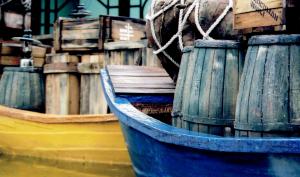20% off all products! Sale ends tonight at midnight EST.
Blog #3 of 3
 Previous
Previous
|
Next
August 17th, 2015 - 10:02 AM

Legend has it that long ago, when what is now Singapore was known as Temasek, a Javanese word meaning “sea”, a grand and majestic creature would rise from the depths of the ocean to protect the land and its people from peril. The beast, its plankton-entangled golden mane framing its lion head and it scales that shimmered like a thousand pearls enrobing its fish-like tail, served as the area’s guardian for generations. Today its memory is sung in songs, recited in poems, and immortalized in statues. The most remarkable thing about this legend, however, is that it is not a legend at all, but a contemporary tale, only slightly more than forty years old.
As a former professional marketer, I am enthralled by the story behind the story. The truth is that the Merlion was first envisioned in 1964 as an emblem for the Singapore Tourist Promotion Board (STPB). The Merlion was not born of the sea, but in the mind of a man, designed by Fraser Brunner, a member of the souvenir committee and a curator of the Van Kleef Aquarium.
This manufactured icon was, nevertheless, beautiful in its poetic symmetry. The Merlion’s head represents the creature (taken for a lion) that was spotted by Prince Sang Nila Utama of the Sri Vijaya Empire when he rediscovered the island in the 11th Century C.E. The prince later renamed the land “Singapura”, which in Sanskrit means “Lion City”. The Merlion’s tail recalls the modest origin of the ancient city of Temasek, a small fishing village. As one local Singaporean journalist eloquently put it in The Sunday Times on April 11, 1999, the Merlion “represents fusion of memory and imagination.”
Today, when countless tourists flock to modern Singapore to visit the five official Merlion statues sprinkled throughout the city-state, they are regaled with the modern Merlion “legend”. It is rare that I have encountered such a sophisticated and successful promotional enterprise, and I truly appreciate the immensity of the genius behind it.
While the intention of the STPB was never to mislead prospective tourists into believing the Merlion legend that’s been popularized through such venues as the Merlion attraction on Sentosa Island, a Singaporean theme park, the fact remains that this innovative use of imagery, history, art, and folklore is an extremely successful promotional program of which the STPB should be proud.
Creating a sustainable tourist attraction with a close affinity to a fictional story has only successfully been accomplished a few times. Possibly the best known instance of this was Walt Disney World’s erection of Cinderella’s Castle in 1971, which was a physical manifestation of the previously only imagined castle depicted in the 1950 movie (although, to be fair, I should point out that the castle’s design was heavily influenced by Neuschwanstein castle in Bavaria, Germany). The animated film serves as an ongoing promotion for the theme park, just as the Merlion legend continuously supports and encourages tourism in Singapore.
Having been an independent republic for fewer than 45 years, Singapore is a young nation by anyone’s standards. Spanning only 272 square miles, it is tiny in terms of land mass, but Singapore’s sophisticated marketing savvy would seem to belie its youth and geographic dimensions. This is one of the great success stories of the modern world of commerce, and why Singapore is recognized today as one of the most modern nations in Asia with such a strong economy. The lesson here is to think big, regardless of your size. The possibilities are as large as your imagination, as large as the “mythical” Merlion that teaches us that nothing is without reach, and no idea is too big to be realized.
Comments
There are no comments on this blog. Click here to post the first comment.